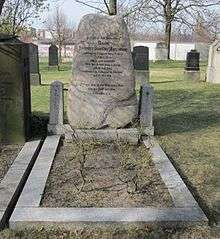Olivier Freiherr von Beaulieu-Marconnay
| Olivier Freiherr von Beaulieu-Marconnay | |
|---|---|
| Nickname(s) | Bauli |
| Born |
14 September 1898 Berlin-Charlottenburg, Germany |
| Died |
26 October 1918 (aged 20) Arlon, Belgium |
| Buried | Invalidenfriedhof Berlin |
| Allegiance | German Empire |
| Service/branch | Dragoons, Air Service |
| Years of service | 1914–1918 |
| Rank | Leutnant |
| Unit | 4th Prussian Dragoon Regiment, Jagdstaffel 15 |
| Commands held | Jagdstaffel 19 |
| Awards | Pour le Merite, Iron Cross First Class |

Leutnant Olivier Freiherr von Beaulieu-Marconnay (14 September 1898 – 26 October 1918) was a German World War I ace fighter pilot credited with 25 victories. He is notable for being World War I's youngest recipient of Germany's highest decoration for military valor, the Pour le Merite.[1][2]
Early life and service
Olivier Freiherr (Baron) von Beaulieu-Marconnay was born in Charlottenburg on 14 September 1898, the son of an aristocratic Prussian army captain. When World War I started in August 1914, he was a sixteen-year-old high school student. The following year, still 16, he volunteered as a cadet for service in his father's former regiment, the 4th Prussian Dragoons. He served with the Dragoons in Russia, and participated in fighting in the Rokitno Swamps in the summer of 1916. He was promoted to leutnant in July 1916, being awarded the Iron Cross First Class later in the year.[2]
Aerial Service
He then transferred to the German air service in 1917 and by November had qualified as a pilot. On 1 December 1917 he was assigned to Jagdstaffel 18. He paid tribute to the 4th Prussian Dragoons by having a personal insignia painted on all his planes consisting of a numeral 4 merged with a capital letter D. His planes also featured a blue fuselage, yellow wheel covers, and nose painted yellow back to the cockpit. Beaulieu-Marconnay served with Jasta 18 without success until his transfer to Josef Veltjens' Jagdstaffel 15 on 20 March 1918.[2]
Jasta 15 had recently received the new Siemens-Schuckert D.III fighters, and were limited to defensive operations, as they had orders forbidding flights over enemy lines lest one of the new planes fall into Allied hands. However, on 28 May 1918, a formation of French Dorand AR.2s were reported over German held territory. The jasta scrambled to intercept and Beaulieu-Marconnay scored his first victory.[3]
The following month he scored regularly becoming an ace on 11 June and a week later had run his total to eight. A double victory on 9 August made him a double ace. He went on to score three more victories in August.[1][2]
Despite being only 19 years old, Beaulieu-Marconnay was then appointed to command Jagdstaffel 19 on 4 September.[4] He would begin his tenure as commander by totalling ten victories in September, and four more in October. His 25th and last confirmed victory came on 10 October 1918.[1][2]
On October 18, in the confusion of a dogfight, Beaulieu-Marconnay was seriously wounded in the thigh, possibly as a result of 'friendly fire' from a fellow German pilot[2] from Jagdstaffel 74. He managed to regain his home airfield and land safely, and was rushed to the hospital, bleeding freely and in very critical condition.
The award of the Pour le Merite was reportedly rushed through as the Blue Max could not be awarded posthumously, and to procrastinate risked the young ace's death while he was honored with only the Iron Cross.[2] Notice of the award was forwarded to the hospital on 26 October 1918. He was the youngest recipient of the 'Blue Max'. However, Olivier Freiherr von Beaulieu-Marconnay, who had lingered with his wound for ten days, died six hours before the news arrived, possibly as the result of a post-operative infection.[5]
He was buried in the famous Invalidenfriedhof in Berlin.[1][6]
Inline citations
- 1 2 3 4 The Aerodrome website http://www.theaerodrome.com/aces/germany/beaulieu-marconnay.php
- 1 2 3 4 5 6 7 Franks et al 1993, p. 68.,
- ↑ Jagdgeschwader Nr II Geschwader 'Berthold'. p. 40.
- ↑ Jagdgeschwader Nr II Geschwader 'Berthold'. p. 90.
- ↑ Jagdgeschwader Nr II Geschwader 'Berthold'. pp. 112–113.
- ↑ Wikimedia commons http://commons.wikimedia.org/wiki/Invalidenfriedhof
References
- Franks, Norman; Bailey, Frank W.; Guest, Russell. Above the Lines: The Aces and Fighter Units of the German Air Service, Naval Air Service and Flanders Marine Corps, 1914–1918. Grub Street, 1993. ISBN 0-948817-73-9, ISBN 978-0-948817-73-1.
- VanWyngarden, Greg; Dempsey, Harry. Jagdgeschwader Nr II: Geschwader Berthold. Osprey Publishing, 2005. ISBN 1-84176-727-1, ISBN 978-1-84176-727-7.